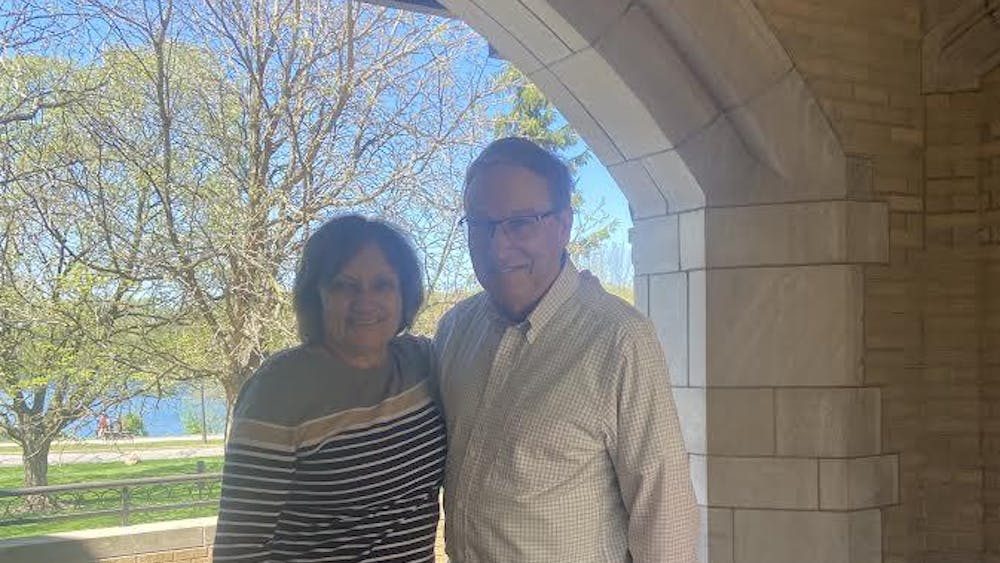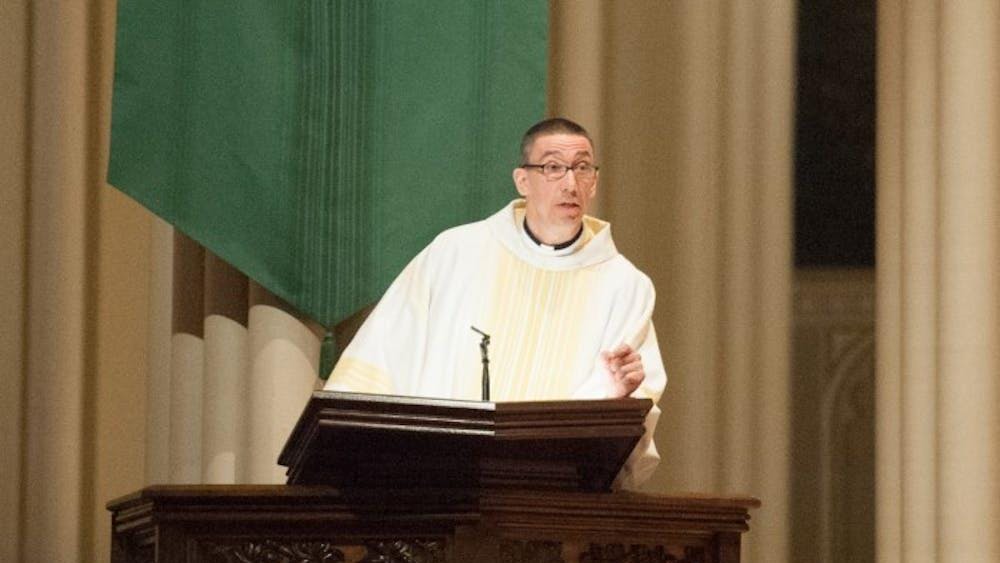In the past year, more than 22,000 high school students have submitted an application to join the Notre Dame class of 2023. At the end of a long process of discernment by the Office of Admissions, 3,515 of those students were admitted to the University. Of that group, about 2,055 accepted Notre Dame’s offer of admission and are expected to arrive on campus this weekend as the class of 2023.
Don Bishop, the University’s associate vice president for undergraduate enrollment, said the class of 2023’s yield rate — the number of admitted students who decided to come to Notre Dame — of 58.4% is a full percentage point higher than last year. This increased yield rate comes in spite of the fact that 90 fewer students were admitted this year as compared to last year.
“We were able to admit fewer students and get our class goal,” Bishop said.
Bishop said the school has sought to recruit an applicant pool comprised of students who have a competitive chance of admission. He attributed the University’s record low acceptance rate of 15.8% last year to the higher quality of students in the applicant pool.
“The admit rate was 15.8%. That’s the lowest admit rate we’ve ever had. I don’t want us to celebrate that. We are not out there trying to accumulate applicants that don’t have much of an opportunity in the pool,” he said. “… We always are trying to improve the applicant pool in the quality of students and that quality definition extends beyond test scores and high school grades.
”But we really looked to increase the applicant pool with students who have the credentials that at least give them a 50/50 chance of admission. This year, the applicant pool went up 9% over the year before, but it went up 23% in these types of what you would call ‘higher profile’ applicants.”
From a demographic perspective, the incoming freshman class is more diverse on several different scores, Bishop said. The proportion of the incoming class made up by students of color from the United States is 29%, up from last year’s 26%. The class of 2023 includes 318 students that are either international citizens or dual-citizen American students raised abroad by one American parent or one foreign parent.
“We’re six percent pure international, no connection to America whatsoever,” he said. “Another three percent are … born and raised in another country, but they have an American parent, so they’re able to claim dual citizenship.”
Those two groups, along with permanent residents of the United States and American students raised abroad, constitute 16% of the class, Bishop said.
Bishop said 21.3% of students are children of alumni, while the number of students in the class of 2023 who are either first generation college students or recipients of Pell Grants are up “by about 30” individuals when compared to last year. They also represent about 16% of the class, Bishop said. When the number of students receiving significant financial aid from the University is included, that figure jumps to about a fifth of the class.
“If you add in the attribute … of lower income students that would need more than tuition and fees as a scholarship to come here — so they can’t pay a dime of tuition and fees and yet we’ve provided them with the support — when you add in first [generation], Pell and receiving more than tuition and fees, it’s around 22% of the whole class.”
Bishop said the University prioritized recruiting a diverse class, although admissions staff operated under a wide definition of diversity as they built the class.
“We did make an effort and recruit more diversity. ‘Diversity’ as defined in the broadest way — socioeconomic diversity, cultural diversity,” he said. “The largest number of students came from public high schools — 43% — the next percent are Catholic [schools] — I think it’s 38% — and then 19% for private or charter schools.”
Though the school has become more diverse, its share of Catholic students has stayed consistent at about 80%.
“We’re 81.5% Catholic. We’ve always been around 80% to 80-some odd percent [Catholic]. I don’t think that’s new news,” Bishop said. “But if they saw the diversity numbers going up as dramatically as they are, they might’ve said, ‘Well, did the Catholic numbers go down?’ No, we have found more students of color, more lower income Catholics, than ever before.
“So that effort for diversity continued to attract the top Catholics from those diverse backgrounds, actually even more successfully this year than ever before. That’s gratifying. It’s a goal of ours; we want to go out to all these diverse communities and find those who really believe in Notre Dame and the benefits of Notre Dame.”
Geographically, the class is drawn from across the country. The most represented region in the United States is the East Coast, contributing 24% of the class, followed by the Central Midwest at 20%. The West and Southwest, Midwest and South round out the American portion of the class at 19%, 15% and 13% respectively.
“We’re the most nationally diverse university. The average first year student comes from a median distance of 750 miles,” he said. “The gates of Columbia University and the gates of Notre Dame are 702 driving miles apart … So if you’re a New Yorker, you live closer to Notre Dame than the average student who comes to the University.”
Bishop said about a quarter each of the incoming class has decided to study in the College of Arts and Letters, the Mendoza College of Business, the College of Science and either the School of Architecture or College of Engineering.
“I think there’s a real creativity available at Notre Dame to be whatever you want,” he said. “There’s not a sense we’re looking for conformity at all. We’re looking for very different mindsets.”
Bishop said that when considering applicants, the University weighs heavily what might lie behind a student’s successes. In other words, the underlying motivational factors of a student’s accomplishments is an important piece of the admissions puzzle.
“The more that the application numbers go up and the academic profile of the applicant pool goes up the more we feel we can be holistic in our approach, more creative. We’re looking at a student’s motivation for success as a heavy decider,” he said. “And that’s not easy to do. We do our best as we read the file to read it and get a sense of what motivated the student to reach those levels of accomplishments. The accomplishment itself is not sufficient for admission. It’s the whole story.”
Motivation for success, Bishop said, is considered in part because it is closely related to determining which applicants will utilize all of the opportunities Notre Dame has to offer.
“One way you can look at it is why somebody has gone as far as they have and how far they’ve gone from where they were [gives] a great deal of predictive value in predicting how far they will go with what they get here,” he said. “How will they use Notre Dame?
”I think one of the great considerations when we’re picking an applicant pool for the enrolled class is ‘Which students will make the best use of the resources that have been put together at Notre Dame?’ I think more and more our students each year are engaging the academic, the social and the spiritual side of Notre Dame, the mission side of Notre Dame, more than any class before. So we are more selective, but we’re also more on mission.”
Christy Pratt, the University’s director of admissions, credited the admissions staff for their work in seeking to enhance the incoming freshman class. She also noted that this incoming class has one special attribute: it is the last class recruited under retiring director of admissions Bob Mundy.
“The credit goes to the Office of Undergraduate Admissions staff that is reading all of these applications, they are on the road and going to all of these different locations and schools,” Pratt said. “… It’s a lot of work and dedication, and we have an amazing staff that is continuing to meet these goals and really enrich the class in finding these students that are going to come and be a great addition to the Notre Dame community.”
Bishop said the incoming class will increase to the dynamism of the University.
“Each year Notre Dame has advanced its mission to attract a powerful group of young scholars from across the nation and across the globe. The class of 2023 not only impressed our admissions committee — they also inspired us,” he said. “This is the strongest group of intellectually creative and resourceful students we have ever attracted. They come from an increasingly more diverse set of geographic, cultural, ethnic and socio-economic backgrounds as well as fields of academic interests. It is an exciting time to be at Notre Dame.”












